Records of the existence of fish ponds date back to the Middle Ages. In fact, they were a sign of power and kept by the nobility. Fishponds served as a controlled reservoir and originally were created to stock fish for food in many cultures. Furthermore, water gardens have existed since the Egyptians channeled water from the Nile to their private gardens where they grew lotus and papyrus, and kept fish over 3,500 years ago. Fast forward to today where modern methods and materials allow anyone to build a garden pond and stock it with a variety of beautiful plants and fish to enjoy. Moreover, when stocking a pond with fish, the addition of algae-eating fish is beneficial for both the fish and the pond. We have reviewed the 19 best and most effective algae-eating fish for outdoor ponds as a reference guide.
Some types of fish only like to eat algae, while others prefer a balance of insects and other food sources. However, it is important not to overfeed fish as this can contribute to algae overgrowth and may add more matter to the pond than the fish will ingest. Educating oneself about the different types of pond fish there are, their adult size, temperament, and tolerated water temperature is an essential component before adding them to a pond. For example, some pond fish are shy while others like to be seen and will bring pleasure to the viewer as they swim through the water. The 19 best and most effective algae-eating fish for outdoor ponds should match the size of the pond they will inhabit and the climate they will live in.
Why Does Algae Grow in Outdoor Ponds?

Algae’s green color comes from having chlorophyll.
©iStock.com/Alexlky
Algae is a normal growth found in aquatic ecosystems, but the presence of some types of algae may indicate problems with the health of the pond or with the fish, while others are just normal growth. For example, green and string algae ensure a healthy ecosystem as they provide oxygen and energy, and are a great food source. Too much of either one of these algae can result in imbalances in oxygen and could harm or kill the fish. In addition, prolonged exposure to sunlight will speed the growth of algae as well as overfeeding fish.
It is best to locate ponds in shaded areas that are not too close to trees so as not to create a problem with falling leaves. Badly maintained filtration systems may also cause algae to spread quickly. Always keep the pond free of debris, fallen leaves, and anything that can decay in the water as it will cause algae growth to increase, affect the chemical balance of the ecosystem, and endanger the fish inhabiting the pond.
Being familiar with the good and bad types of algae will ensure an optimal environment for both fish and plants. Too much algae will create problems and need to be thinned out. In addition, if the chemical balance of the pond is off it may cause an increase in algae growth which may be harmful for the fish. Other reasons for excessive algae growth include high levels of nutrients in the water such as nitrogen or phosphorus which are caused by:
- Animal waste in the pond
- Urban runoff
- Septic systems
- Manures
- Fertilizers
Ponds may develop pond weeds which may be manually removed using a pond rake or skimmer. For those that take root, use a weed cutter.
The 19 Best and Most Effective Algae-Eating Fish for Outdoor Ponds
Choosing the right fish for a pond is an important element in controlling algae. Therefore, the 19 best and most effective algae-eating fish for outdoor ponds are:
- Japanese koi
- Goldfish
- Grass carp
- Dojo Loach
- Otocinclus
- Nerite snail
- Plecostomus
- Bullfrog tadpole
- Mosquitofish
- Molly fish
- Japanese trapdoor snail
- Siamese algae eater
- Channel catfish
- Apple snail
- Chinese algae eater
- Flying fox
- Gold nugget pleco
- Chinese high-fin banded shark
- Shubunkin goldfish
Japanese Koi (Cyprinus rubrofuscus)
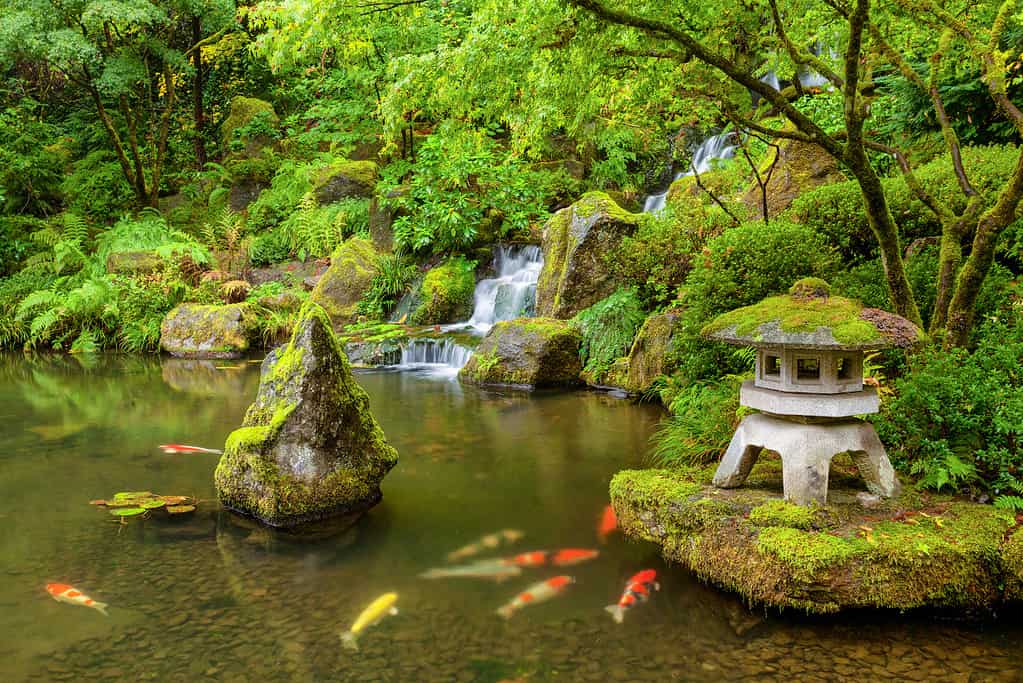
A beautiful Japanese garden pond with
koi fish
.
©paulacobleigh/ via Getty Images
Japanese koi are related to carp. In fact, Japanese rice farmers domesticated them in the 19th century. In Japan, koi are called Nishikigoi. This translates to mean the “swimming jewel.” They symbolize good fortune, prosperity, and luck. They come in a variety of colors from black, orange, or white, or a combination of them, and on rare occasions they are blue. Koi will grow up to 2-3 feet in length and weigh up to 35 pounds. Their preferred diet consists of algae, plants, and aquatic insects. They breed annually and will stick their eggs on water plants and other submerged objects. On average, they live up to 40 years. However, there was one that reached the ripe old age of 230 years according to some! Give them a shaded area as they are prone to sunburn.
Goldfish (Carassius auratus)

Goldfish sleep with their eyes open.
©chrisbrignell/Shutterstock.com
This cousin of the koi is native to East Asia and domesticated by the Chinese. They live on average 10-15 years, grow up to 10-12 inches in length, and feed on algae and other plants as well as detritus, other invertebrates, and insects. They thrive in outdoor ponds at temperatures of 40 degrees Fahrenheit (4.4 degrees C) or above.
Grass Carp (Ctenopharyngodon idella)

Grass carp don’t have whiskers, or barrels, like other carp members.
©Rostislav Stefanek/Shutterstock.com
Related to koi and goldfish, this large fish is a member of the minnow family and is native to East Asia. Grass carp will grow up to 5 feet in length and weigh around 40 pounds. Therefore, they are not a good choice for smaller ponds. They are greenish-brown in color with silvery sides and large black or dark brown scales giving them a distinctive “fishnet” pattern. Grass carp will eat a variety of water plants including algae-eating and may daily consume up to three times their weight. In China, grass carp are bred as a food source.
Dojo Loach (Misgurnus anguillicaudatus)
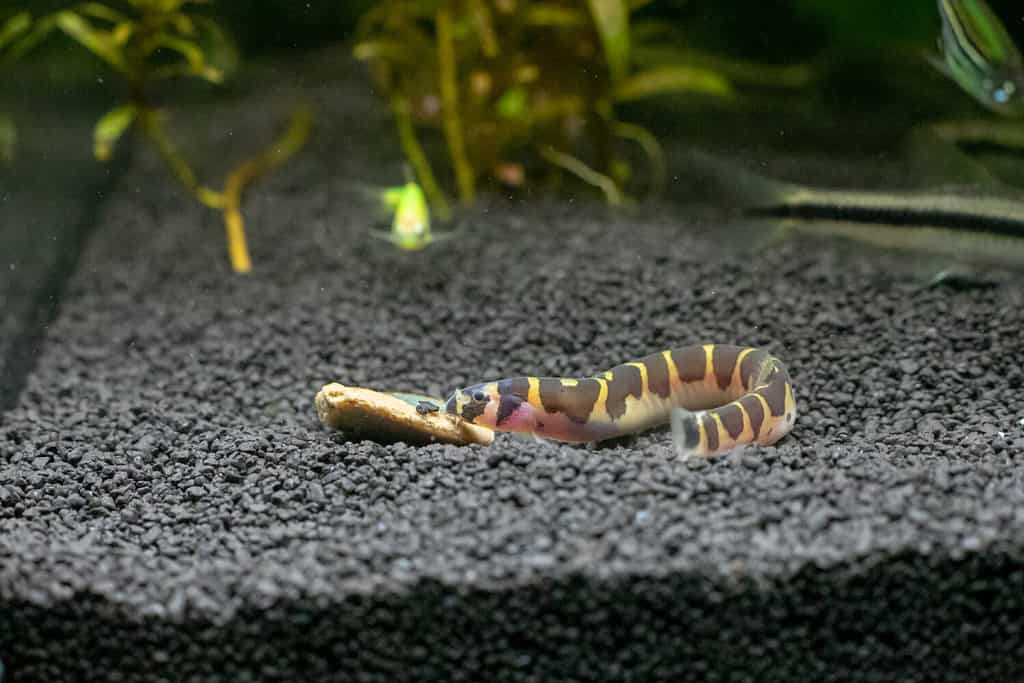
The loach prefers to be in groups in ponds and can get lonely if they aren’t.
©Olga Chezhina/Shutterstock.com
Also known as pond loach or weather loach, this whiskered eel-like fish is native to East Asia. They can grow up to 10 inches in length and come in a variety of colors such as gray, albino, pink, or orange. This bottom-feeding fish loves to eat algae, small aquatic invertebrates, and tubifex worms. These social fish approach people at the pond’s edge where they are often hand-fed.
Otocinclus (Otocinclus)
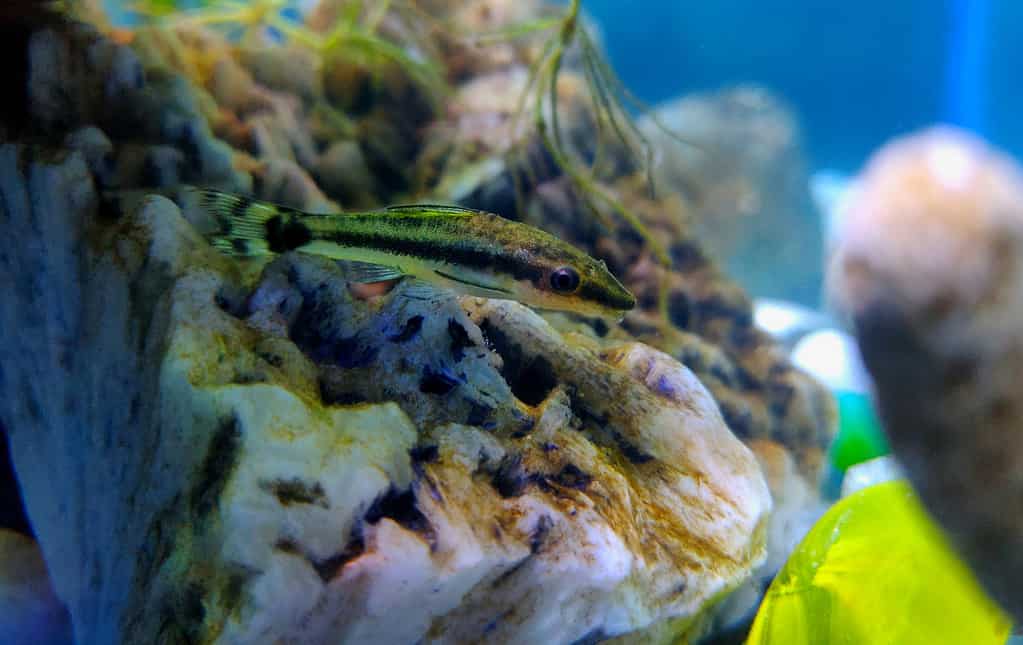
Otocinclus catfish have a peaceful demeanor.
©Saurabhkumar Singh/iStock / Getty Images Plus via Getty Images
A relative of the catfish, these small fish are native to South America. They average 1.5 to 2 inches in length. Also called otos or dwarf suckers, their long narrow bodies have a horizontal stripe. A unique feature of these fish is their ability to breathe air. This occurs by an adaptation of a junction between their esophagus and stomach. They enjoy eating algae and other plants.
Nerite Snail (Neritina natalensis)

Named after the Greek sea god Nerites.
©iStock.com/Juan Carlos Juarez Jaramillo
The lifespan of this small proficient algae eater is merely one year. They are native to Africa and range in size from .5 to 1 inch, sometimes they will reach 1.5 inches. Also known as Spotted Nerite Snails, Tiger Nerite Snails, and Zebra Nerite Snails, they come in many patterns and colors making them an attractive addition to any pond!
Plecostomus (Hypostomus Plecostomus)
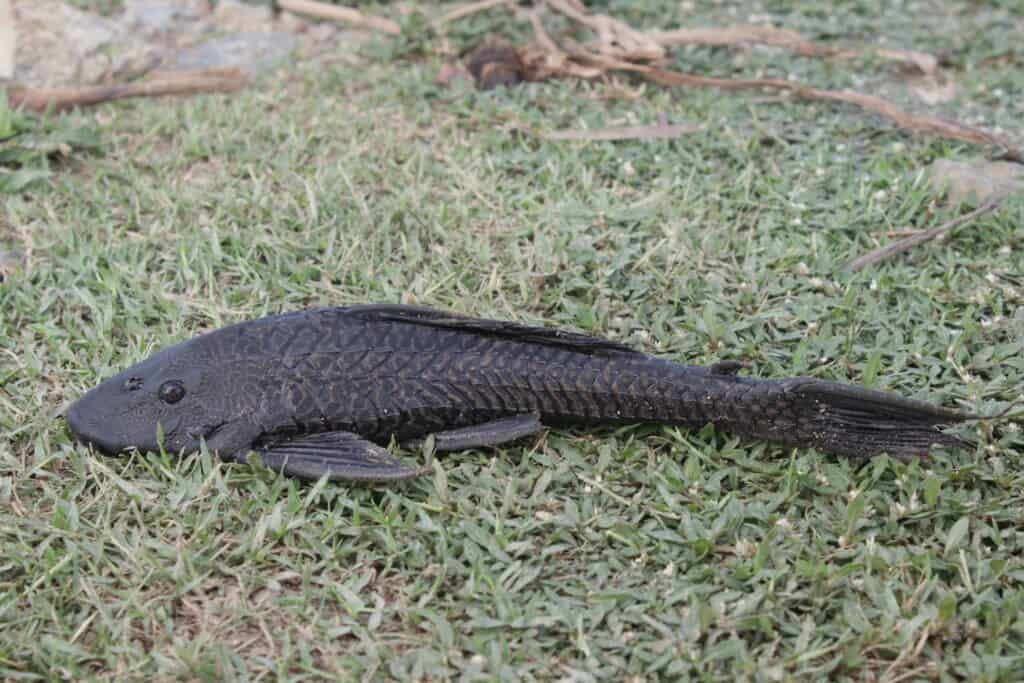
Due to its ability to hold air, the armored catfish can “walk” by using its flat bottom and powerful fins.
©Rosyid Azhai/Shutterstock.com
A member of the catfish family, the Plecostomus includes a few species which include the common pleco, rhino pleco, and spotted pleco. Also known as the suckermouth catfish. The different species vary in size, but they average about 20 inches in length and live 10-15 years. A smaller variety of the pleco is the albino bristlenose pleco which is about 5 inches long. Algae, detritus as well as lettuce, cucumber, or zucchini, and occasionally newly hatched snails, invertebrates, small fish, and small crustaceans are their choice of food. In fact, this tropical fish is native to South America and is capable of breathing air. Their coloration depends on their surroundings which vary from dark brown to a sandy color with black spots. They are nocturnal and spend their days in dark crevices.
Bullfrog Tadpole (Lithobates catesbeianus)
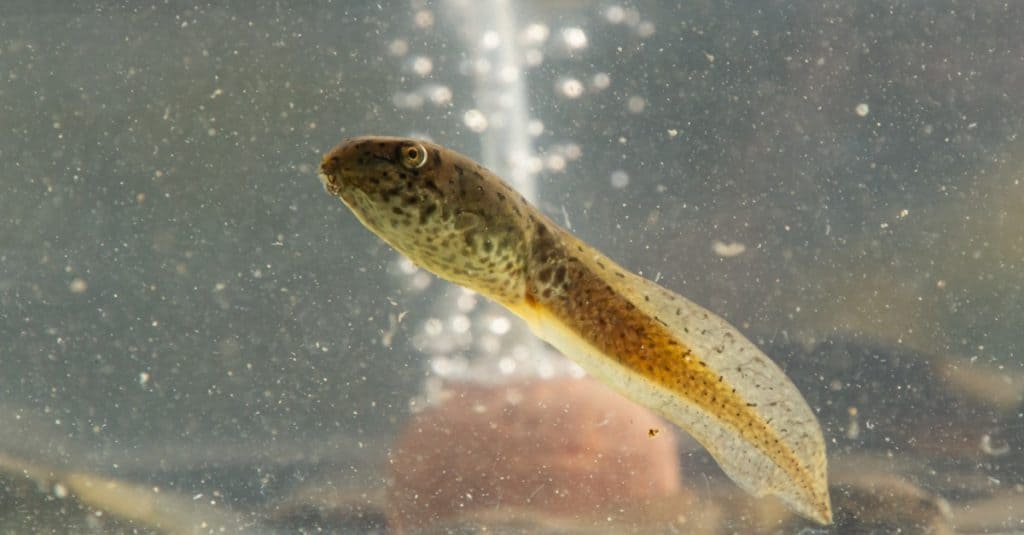
A bullfrog tadpole can grow to 6 inches in length.
©Umaporn Tepumong/Shutterstock.com
The larval stage of a bullfrog tadpole lasts from a few months to 3 years. During this period their diet consists of algae, mosquito larvae, aquatic plants, and some invertebrates. Their lifecycle includes egg, tadpole, tadpole with legs, and then transition to adult bullfrogs who live for 7-10 years. The adult bullfrog does not care for algae, so they will look for other food sources. They are native to the southern, eastern, and midwestern United States and range in color from light to dark green and may have dark spots.
Mosquitofish (Gambusia affinis)
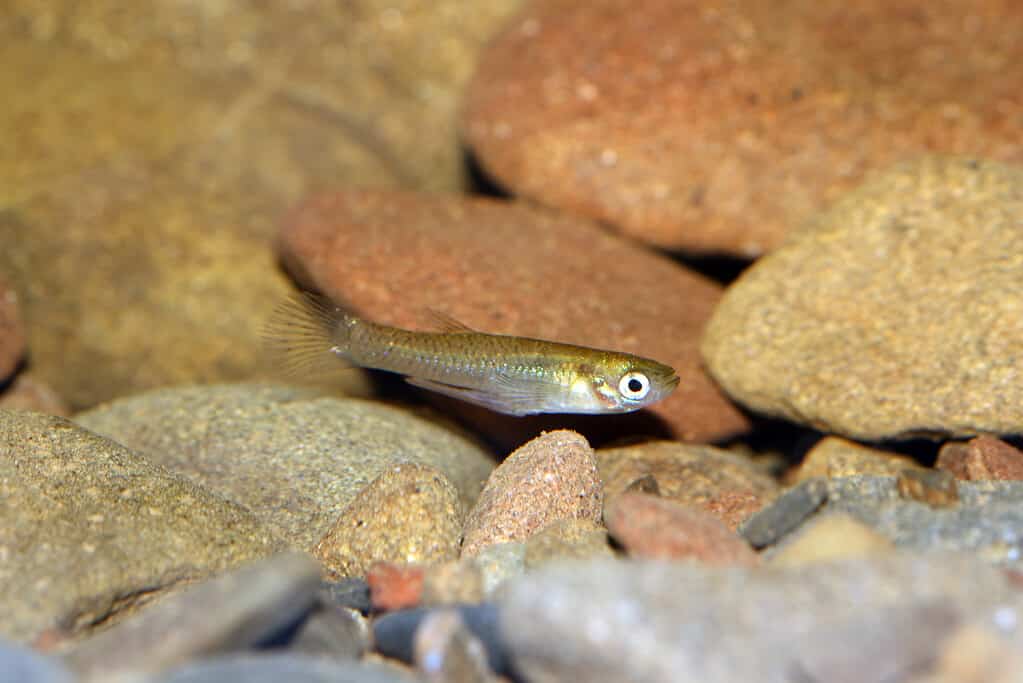
A mosquitofish can breathe air from the water’s surface.
©angeluisma/iStock via Getty Images
This small North American freshwater fish is about 1.5 to 2.5 inches in length with the female being the larger of the species. In fact, they give birth to live young. Aptly named, they will eat mosquito larvae, insects, small invertebrates, and plants including algae. Moreover, they are capable of eating hundreds of mosquito larvae in a day.
Molly Fish (Poecilia sphenops)
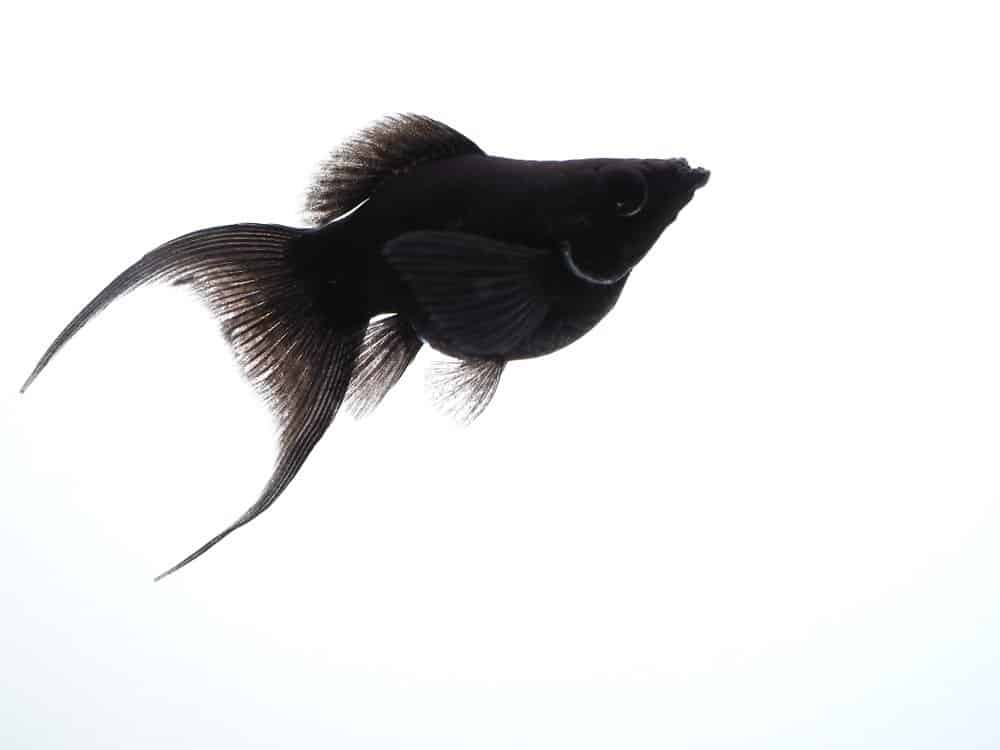
Molly fish get along well with other fish.
©Palomasius/Shutterstock.com
Native to Mexico and Colombia, this fish is around 2-5 inches in length and comes in several varieties which include silver, black, white, golden, or dalmatian. They give birth to live young and reproduce readily.
Japanese Trapdoor Snail (Viviparis malleatus)
These large freshwater snails are native to East Asia and North America, vary in color from dark green to brown or black, and are capable of asexual reproduction. In addition to being voracious algae eaters, they will eat decaying vegetation. These are live-bearing snails and as adults can grow to a length of 2 inches. They are able to tolerate cold temperatures. However, it is important to keep them confined as they can become invasive in the natural environment.
Siamese Algae Eater (Crossocheilus oblongus)
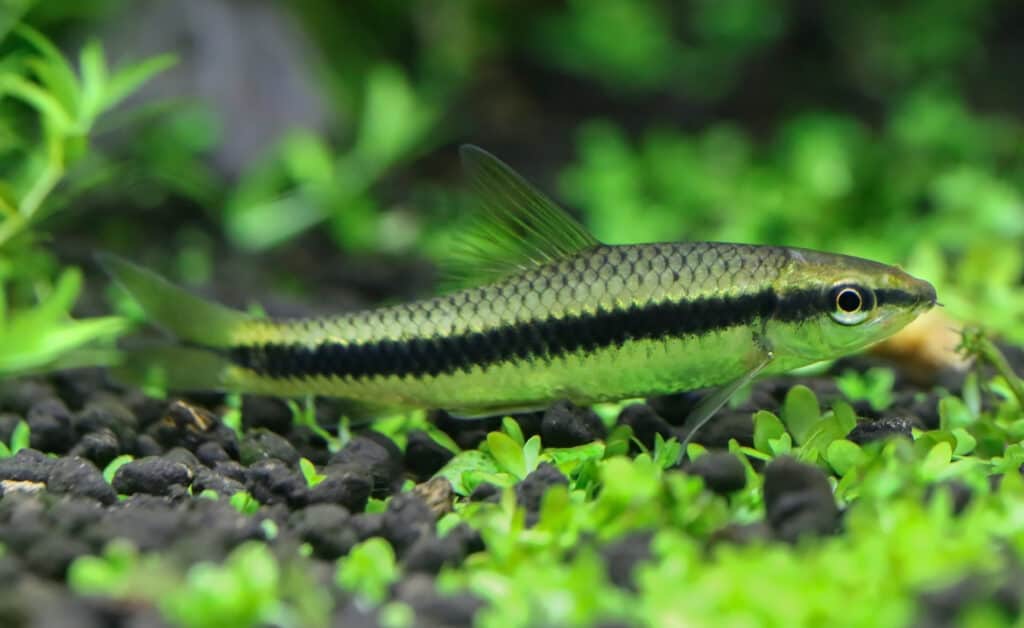
This fish will also eat meat.
©Swapan Photography/Shutterstock.com
This beautiful freshwater member of the carp family is native to Southeast Asia. They like to eat vegetable matter, fresh vegetables, and algae. Their long, sleek bodies boast vibrant colors of grey or gold with a thick black horizontal stripe running from head to tail. They will grow to a length of 6 inches and live about 10 years. However, they do not tolerate cold water well.
Channel Catfish (Ictalurus punctatus)

Channel catfish are known as the “swimming tongue.”
©Alauddin Abbasi/Shutterstock.com
Native to North America, these fish can reach upwards of 40-51 pounds. They average 16-24 inches in length but have been known to reach over 4 feet. Their lifespan is around 15-20 years and are best for larger ponds. In fact, channel catfish have taste buds over their entire bodies, most are located around their whiskers and gills. They are grayish-blue with a black back and white belly; the albino trait may appear peach-colored. These bottom dwellers like aquatic insects and plants as well as algae.
Apple Snail (Ampullariidae)
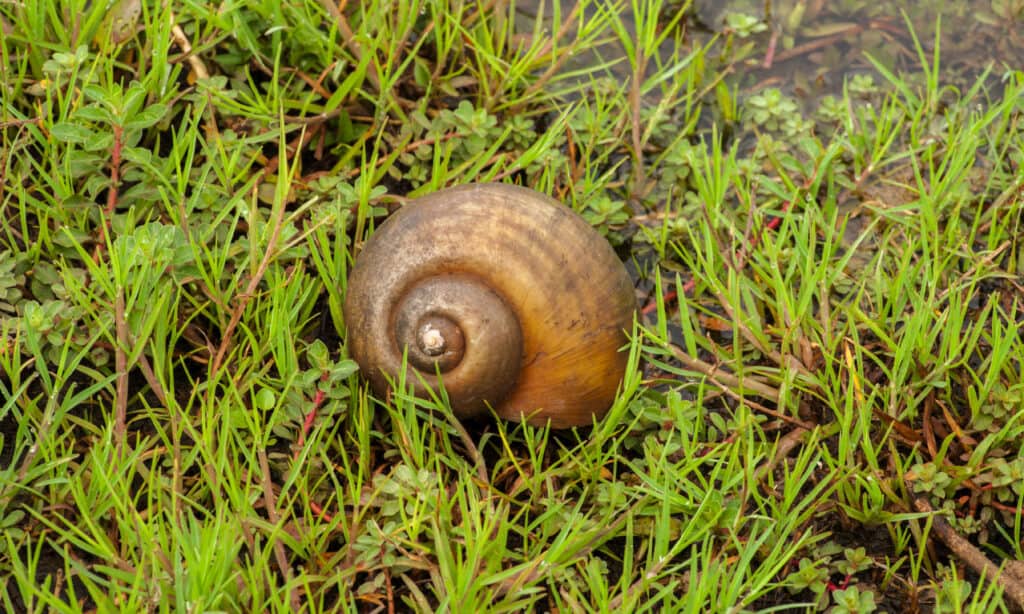
Apple snails have a gill and a fully functioning lung.
©Asian Images/Shutterstock.com
These amphibious snails are native to South and Central America, and the West Indies. However, they are invasive and illegal in some areas of the United States. The Mystery Snail is one variety found in the United States. Their colors range from bright yellow to brown, blue, or light pink and they reach up to 5.9 inches in length making them the biggest freshwater snail on the planet. In addition, they like to eat live or dead plant matter and algae and can damage pond plants not meant for consumption. They prefer warmer water in the range of 70-80 degrees.
Chinese Algae Eater (Gyrinocheilus aymonieri)

Chinese algae eaters can breathe without using their mouths, they have gills with two slits.
©Joan Carles Juarez/Shutterstock.com
Native to Southeast Asia, they are also called honey suckers and sucking loach. Local markets sell them as a food source. They are herbivores and love to eat algae and make a great addition to a pond. They are 6 inches in length and come in a variety of colors from olive to pale grey with a solid stipe or dots. Chinese Algae Eaters prefer warmer water and are easy to care for.
Flying Fox Fish (Epalzeorhynchos kalopterus)
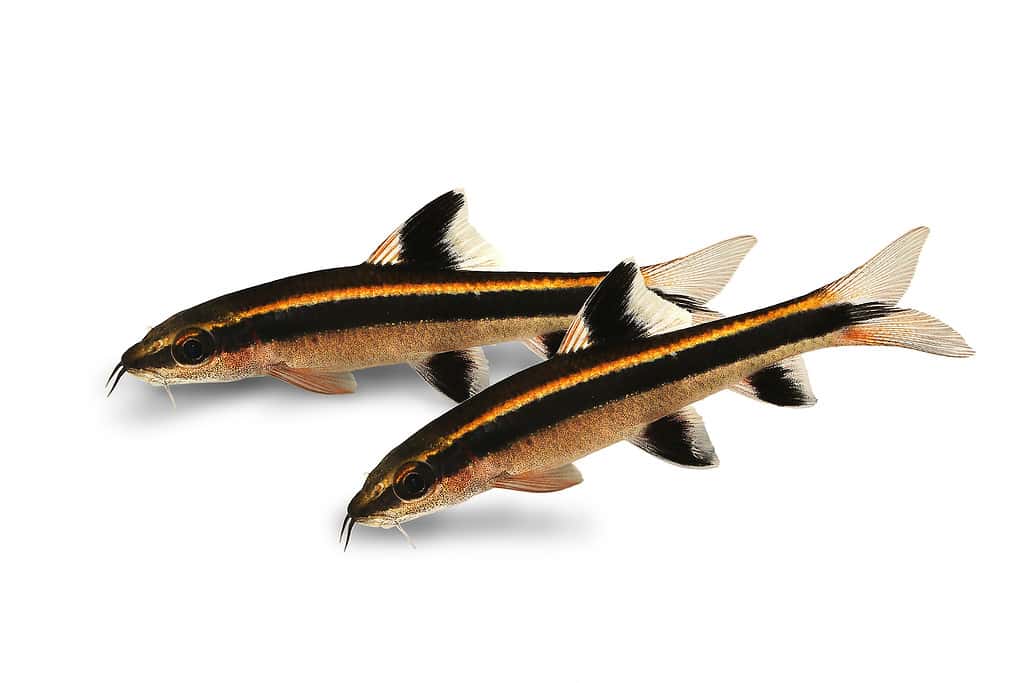
Flying fox fish are skittish and spend much of their time hiding.
©Mirko_Rosenau/iStock via Getty Images
Native to Southeast Asia these beautiful fish prefer warmer water. They are often confused with the Chinese algae eater. They average in size around 4.7 inches with a lifespan of 8-10 years. Their colors range from olive green to dark brown with a black line from mouth to tail. Vegetables, tubifex worms, crustaceans, aquatic insects, and algae, except for red algae, round out their diet.
Gold Nugget Pleco (Baryancistrus xanthellus)
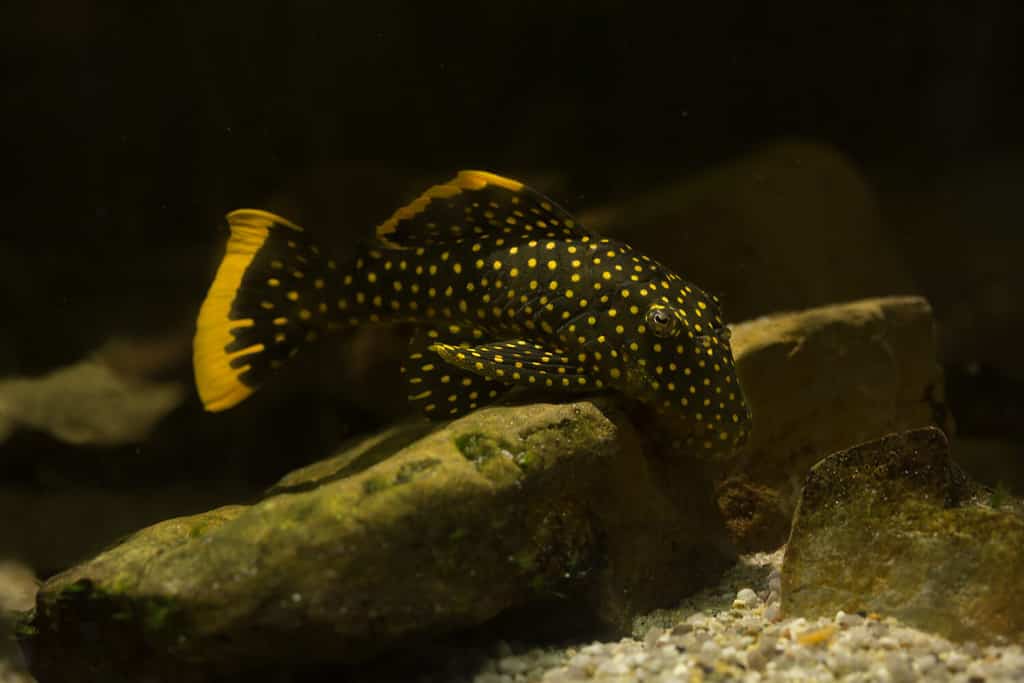
Pleco and goldfish are not recommended as pondmates.
©Podolnaya Elena/Shutterstock.com
A member of the catfish family, this black and yellow spotted fish is a native of Brazil and lives in the Amazon River. They grow to a length of 12 inches and love to eat algae. Additionally, they are a pleasure to look at.
Chinese High Fin Banded Shark (Myxocyprinus asiaticus)

The Chinese High Fin Banded Shark is a peaceful fish.
©Pavaphon Supanantananont/Shutterstock.com
This large fish is native to China and grows to about 4.5 feet in length. It is also known as Entsuyui in Japan, Chinese banded shark, Siamese sucker, Chinese emperor, Chinese or Asian zebra high-fin sucker, rough fish, Hilsa herring, freshwater batfish, wimple, wimple carp, Chinese sucker, Asian sucker, topsail sucker, sailfin sucker, Chinese high-fin sucker, high-fin loach, banded loach, high-fin, or Chinese sailfin sucker. They have brown bodies with three dark slanted bands around them and a high, triangular dorsal fin. Their lifespan is around 25 years. They are herbivores, love to eat algae, and are tolerant to cold water in the range of 55-75 degrees Fahrenheit (12-23 C).
Shubunkin Goldfish (Carassius auratus)
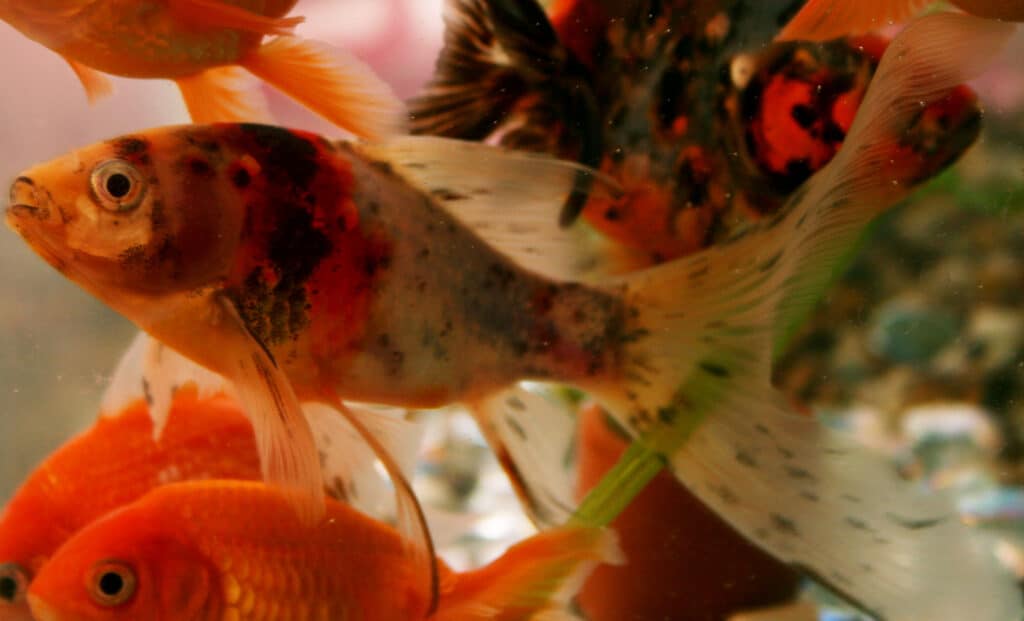
These voracious eaters will eat anything small enough to fit in their mouth.
©Humanfeather / Michelle jo, CC BY 3.0 <https://creativecommons.org/licenses/by/3.0>, via Wikimedia Commons – License
Native to Japan, Shubunkin goldfish resemble koi fish and are a cross between a common goldfish, a comet goldfish, and a calico telescope eye. Their silvery bodies come in patches of orange and black. There are three varieties including the Bristol, London, and American which differ in their fin and body shapes. In fact, the most prized color is blue. They will grow to 9-18 inches in length and have a lifespan of 10-15 years. Their favorite food is algae. Cold temperatures are well tolerated by this fish.
How to Keep a Pond Clean and Healthy for the 19 Best and Most Effective Algae-Eating Fish for Outdoor Ponds
- Clean the pond regularly with a skimmer to collect leaves and a pond vacuum to remove mud from the bottom.
- Manage nearby plants by installing a net over the pond to catch the leaves of nearby trees and to protect it from predators.
- Grow water plants such as marshes, floaters, marginals, lilies, and oxygenators. Make sure they do not cover the entire surface.
- Control ice in the winter to prevent lowered oxygen levels below water and lower pond temperatures. De-ice, add a heater, or install a translucent cover to allow for sunlight.
- Control algae growth by introducing lilies to minimize the sunlight that reaches algae. Algaecides will keep algae under control and are safe for fish and aquatic plants.
- Maintain the pump, filter, lines, and fountains by clearing clogs, flushing debris, and partially cleaning the biological filter to avoid killing useful bacteria. Additionally, limescale and algae bloom removal is done with cleaning chemicals and algaecides.
- Troubleshoot and repair leaks which may be indicated by lower water levels or if the surrounding area is wet.
- Maintain the right water level as it may drop in warmer weather causing a lack of oxygen in the pond. Importantly, it should be checked regularly throughout the summer months.
- Maintain the right temperature during winter when ice may form by using a heater to keep the temperature optimal. During the summer, water temperature can heat up which can be remedied by topping off the pond with cold water to bring the temperature down.
- Keep it well-aerated to benefit plants and animals, reduce algae growth, and eliminate odor to create an enjoyable water garden. Oxygenating plants will improve oxygen levels as well as fountains, bubblers, and waterfalls which move air in and out of the water. An air pump will also help with air levels.
- To keep the water chemistry optimum, things like chlorine can interfere with it and kill aquatic organisms. Actually, it may also be altered by decaying plants. Detoxifiers and alkaline solutions will control toxic and acidic conditions. In fact, edging may help solve problems with water runoff.
In Conclusion
Outdoor ponds bring a sense of tranquility to a garden as well as other beneficial creatures that will stop by to visit. Maintaining a pond requires some work, but the rewards are more than worth it. In landscape design, outdoor ponds serve as a focal point, and with lighting, they become a dramatic feature. In fact, ponds provide a place of refuge for creatures such as dragonflies which breed and eat mosquitos, salamanders, newts, damselflies, as well as a variety of birds. Include native plants to provide cover and a source of food for all the garden creatures to enjoy.
| Algae-eating fish | Place of origin |
|---|---|
| Japanese Koi | Japan |
| Goldfish | East Asia |
| Grass carp | East Asia |
| Dojo Loach | East Asia |
| Otocinclus | South America |
| Nerite snail | Africa |
| Plecostomus | South America |
| Bullfrog tadpole | Southern, eastern, and midwestern United States |
| Mosquitofish | North America |
| Molly fish | Mexico and Colombia |
| Japanese trapdoor snail | Japan |
| Siamese algae eater | Southeast Asia |
| Channel catfish | North America |
| Apple snail | South and Central America, and the West Indies |
| Chinese algae eater | China |
| Flying fox | Southeast Asia |
| Gold nugget pleco | Brazil |
| Chinese high-fin banded shark | China |
| Shubunkin goldfish | Japan |
The photo featured at the top of this post is © redgirldiving/Shutterstock.com
Thank you for reading! Have some feedback for us? Contact the AZ Animals editorial team.






